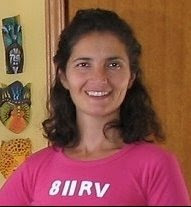8/29/2009
Bananas=Blueberries-WTF(what the fruit)!
On my last posthttp://via811.blogspot.com/2009/08/one-chimp-can-eat-30-bananas-day-if-we.html, I claimed that I basically eat a wild bonobo chimp diet. You're probably saying to yourself: "I bet she hasn't even been to equatorial Africa where bonobo chimps live (true). Nor has she ever even tasted a Batofe fruit that bonobos exclusively forage on for weeks at a time, as described by Takayoshi Kano in The Last Ape: Pygmy Chimpanzee Behavior and Ecology (equally true). Now, she's saying bananas=blueberries. WTF (what the fruit) is she talking about?"
The "Law of Similars" is my topic of the day. Let's do some nutritional analysis together. According to http://www.nutridiary.com, which sources its data from the USDA, we can make some very interesting comparisons. This site primarily analyzes the different macro nutrient ratios of foods. The macro nutrients are carbohydrates, proteins and fats. Dr. Graham and his wife Rozalind have renamed these "caloronutrients" because they are the only nutrients that provide calories or the fuel energy used by the body.
Ok, pick a fruit, any fruit. I'll start:
100 grams/bananas= 93% carbs, 4% protein, 3% fat
100 grams/blueberries= 90% carbs, 5% protein, 5% fat
100 grams/crabapples= 95% carbs, 2.5% protein, 2.5% fat (this sour fruit surprised you, didn't it?)
100 grams/sourcherries=88% carbs, 7% protein, 5% fat
Just from this small sampling we can see a pattern emerging. Fruits have an average caloronutrient ratio of 90% carbs, 5% protein, 5% fat. This is their bell curve.
But wait, what about avocados or durians, what's up with them?
100 grams/avocados= 20% carbs, 5% protein, 75% fat
100 grams/durian= 66% carbs, 4% protein, 30% fat
In determining statistical averages (thanks to my DH, PhD and stats genius), these extreme variants are called "outliers". Their relative importance should be studied, but like all exceptions, they prove the rule.
Let's compare some micro nutrients now:vitamins A, C, minerals calcium, iron, omegas 3 and 6 from another site "http://www.nutritiondata.com". This site details some of the micro nutrients that have been identified by scientists.
100gr/bananas= A=64iu, C=8.7mg, calcium=5mg, iron=.3mg, omega3=27mg, omega6=46mg
100gr/blueberries:A=54iu, C=9.7mg, calcium=6mg, iron=.3mg, omega3=58mg, omega6=88mg
Are you surprised to see that both bananas and blueberries have these micro nutrients? If you're like most people, you probably associate carrots with vitamin A, oranges with vitamin C, milk with calcium, meat with iron, and fish with omega 3. The sad truth is: the industries that most benefit from these products have done a fine job of brainwashing people into believing that the highest source of these nutrients is the best source. In fact, the best source is the one found in the natural diet of each species. For example, a cat doesn't need to ingest vitamin C, but a human does. This is what is called an essential nutrient. Too much of a nutrient is just as bad as too little. Both negatively affect homeostasis, but too much for a cat is not the same as too much for a human. How do you determine what is too much, too little or just right? These are determined by examining the genetics and physiology of each species, for scientists. In nature, however, each species has evolved to know what to eat. In other words, wild chimps don't need human scientists to tell them what to eat. As for captive chimps that have been exposed to humans' denaturing by cultural conditioning, their wild brethren are still much better guides than people are. Believe it or not, but even humans have not lost their natural instincts about what to eat, but it takes a lot of sloughing away of learned habits to be able to listen to our instincts. Wild chimps prove to be better guides, even for humans!
The above list of micro nutrients is a very small sample of the micro nutrients found in bananas and blueberries. Scientists estimate that not even 10% of all micro nutrients have been identified, much less studied. Also, many scientists make the reductionist mistake of macro managing these micro nutrients and giving them more importance than they truly deserve. Effectively, they make mountains out of mole hills. If one eats a whole food, species specific diet and gets enough calories to sustain BMR (Basal metabolic rate)+ one's activity levels, there is no need to sweat about the micro nutrients. But I digress.
Let's go back to bananas and blueberries and resume how The Law of Similars applies to them. How can a long yellow thing that grows on tree-like plants in the tropics be closely related to a small round blue thing that grows on shrubs in Québec's subarctic? One reason is that they are very similar in what matters most nutritionally-their macro nutrient composition. But one little blueberry does not have the same total amount of calories as one average cavendish banana. Therefore, it takes many more bites of blueberries to equal Mr. Banana.
In conclusion, bananas and blueberries are not identical, but they are similar enough in the important stuff to both be FRUITS.
Stay tuned for the sequels to this saga: Green Leafy Vegetables-Popeye Was Right! followed by 75% Fat Ticking Time Bombs-NUTS! and finally Maillard Reaction Products-HomeOSTASIS Wreckers!
The "Law of Similars" is my topic of the day. Let's do some nutritional analysis together. According to http://www.nutridiary.com, which sources its data from the USDA, we can make some very interesting comparisons. This site primarily analyzes the different macro nutrient ratios of foods. The macro nutrients are carbohydrates, proteins and fats. Dr. Graham and his wife Rozalind have renamed these "caloronutrients" because they are the only nutrients that provide calories or the fuel energy used by the body.
Ok, pick a fruit, any fruit. I'll start:
100 grams/bananas= 93% carbs, 4% protein, 3% fat
100 grams/blueberries= 90% carbs, 5% protein, 5% fat
100 grams/crabapples= 95% carbs, 2.5% protein, 2.5% fat (this sour fruit surprised you, didn't it?)
100 grams/sourcherries=88% carbs, 7% protein, 5% fat
Just from this small sampling we can see a pattern emerging. Fruits have an average caloronutrient ratio of 90% carbs, 5% protein, 5% fat. This is their bell curve.
But wait, what about avocados or durians, what's up with them?
100 grams/avocados= 20% carbs, 5% protein, 75% fat
100 grams/durian= 66% carbs, 4% protein, 30% fat
In determining statistical averages (thanks to my DH, PhD and stats genius), these extreme variants are called "outliers". Their relative importance should be studied, but like all exceptions, they prove the rule.
Let's compare some micro nutrients now:vitamins A, C, minerals calcium, iron, omegas 3 and 6 from another site "http://www.nutritiondata.com". This site details some of the micro nutrients that have been identified by scientists.
100gr/bananas= A=64iu, C=8.7mg, calcium=5mg, iron=.3mg, omega3=27mg, omega6=46mg
100gr/blueberries:A=54iu, C=9.7mg, calcium=6mg, iron=.3mg, omega3=58mg, omega6=88mg
Are you surprised to see that both bananas and blueberries have these micro nutrients? If you're like most people, you probably associate carrots with vitamin A, oranges with vitamin C, milk with calcium, meat with iron, and fish with omega 3. The sad truth is: the industries that most benefit from these products have done a fine job of brainwashing people into believing that the highest source of these nutrients is the best source. In fact, the best source is the one found in the natural diet of each species. For example, a cat doesn't need to ingest vitamin C, but a human does. This is what is called an essential nutrient. Too much of a nutrient is just as bad as too little. Both negatively affect homeostasis, but too much for a cat is not the same as too much for a human. How do you determine what is too much, too little or just right? These are determined by examining the genetics and physiology of each species, for scientists. In nature, however, each species has evolved to know what to eat. In other words, wild chimps don't need human scientists to tell them what to eat. As for captive chimps that have been exposed to humans' denaturing by cultural conditioning, their wild brethren are still much better guides than people are. Believe it or not, but even humans have not lost their natural instincts about what to eat, but it takes a lot of sloughing away of learned habits to be able to listen to our instincts. Wild chimps prove to be better guides, even for humans!
The above list of micro nutrients is a very small sample of the micro nutrients found in bananas and blueberries. Scientists estimate that not even 10% of all micro nutrients have been identified, much less studied. Also, many scientists make the reductionist mistake of macro managing these micro nutrients and giving them more importance than they truly deserve. Effectively, they make mountains out of mole hills. If one eats a whole food, species specific diet and gets enough calories to sustain BMR (Basal metabolic rate)+ one's activity levels, there is no need to sweat about the micro nutrients. But I digress.
Let's go back to bananas and blueberries and resume how The Law of Similars applies to them. How can a long yellow thing that grows on tree-like plants in the tropics be closely related to a small round blue thing that grows on shrubs in Québec's subarctic? One reason is that they are very similar in what matters most nutritionally-their macro nutrient composition. But one little blueberry does not have the same total amount of calories as one average cavendish banana. Therefore, it takes many more bites of blueberries to equal Mr. Banana.
In conclusion, bananas and blueberries are not identical, but they are similar enough in the important stuff to both be FRUITS.
Stay tuned for the sequels to this saga: Green Leafy Vegetables-Popeye Was Right! followed by 75% Fat Ticking Time Bombs-NUTS! and finally Maillard Reaction Products-HomeOSTASIS Wreckers!
Subscribe to:
Post Comments (Atom)








2 comments:
can't wait for the sequel
Great write-up! but I thought that Burger King has all the species specific food that anyone could ever need? No? :)
Post a Comment